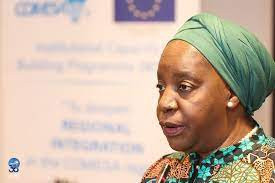The Zimbabwean dollar has been freefalling. It started at an exchange rate of about 1:3 to the US dollar as at February 2019 and by June of 2020, the rate had dampened to about 1:25. In recent weeks, it has tumbled with parallel market rates rising to up to ZW$340:US$1, while the official foreign currency rate at the auction system is now ZW$155,14:US$1. Inflation has also shot up recently to 72,7%. Last week, Zimbabwe Independent (ZI) spoke to Reserve Bank of Zimbabwe (RBZ) governor John Mangudya (JM, pictured) on several issues, including prospects of redollarising and inflation containment. Below are excerpts of the interview:
ZI: The recent interest rate hike is not supportive of the productive sector. What measures are being put in place to ensure that there is adequate funding for production?
JM: The primary mandate of the Bank is to achieve and maintain price and financial system stability, which is a necessary precondition for sustainable economic development. The recent decision by the Monetary Policy Committee (MPC) to increase the interest rates to stem out speculative borrowing, reduce exchange rate instability and inflationary pressures, should therefore be viewed in light of this primary mandate of the Bank. Some companies have been increasingly borrowing to purchase foreign currency on the auction system but continue to charge prices at parallel market rates, thereby, causing instabilities in the foreign exchange market. As such, the tightening of monetary policy through increasing interest rates is aimed at controlling inflationary pressures in the economy.
ZI: The MPC resolution that allows economic agents to transact amounts that do not exceed US$1 000 on a willing buyer willing seller basis is a clear indication of the emergence of a new official exchange rate. Is this the beginning liberalisation of the exchange rate and the end of the Auction System?
JM: The Bank has affirmed through the monetary policy statement and MPC resolutions, to continue refining the auction system and to liberalise the foreign exchange market. You may also recall that, the minimum for the Small to Medium Enterprises (SMEs) foreign exchange is US$2 500, while amounts below this were being met through the Bureux de Change at the prevailing exchange rate plus a cost-plus margin of a maximum of 10%. As such, the liberalisation of the US$1 000 through banks, is a positive move to enhance confidence in the foreign exchange market and to allow for the continuous market price discovery of the exchange rate thus improving the efficacy of the auction system. This policy direction is also expected to go a long way in curbing parallel market activities due to increased scope for trading foreign currency through normal banking channels.

ZI: Inflationary pressures have emerged in the broader economy owing to a number of factors, including geopolitics. What are the new realistic inflation targets for the RBZ in 2022 and 2023, also bearing in mind electioneering activity?
Keep Reading
- Chamisa under fire over US$120K donation
- Mavhunga puts DeMbare into Chibuku quarterfinals
- Pension funds bet on Cabora Bassa oilfields
- Councils defy govt fire tender directive
JM: As was noted by the recent MPC, the Bank is concerned with the increase in annual inflation from 66,1% in February to 72,7% in March 2022. The increase in near-term inflation has been driven by global inflation emanating from Russia-Ukraine conflict which has resulted in significant increases in the price of fuel, food and freight costs. These have negative spill-over effects on the domestic inflation, which is now expected to end the year at between 50% and 70% and declining to between 10% and 20% by end-December 2023.
ZI: There appears to be a lack of transparency on the actual cost of Afreximbank Facilities. Can you give a breakdown on how much is owed, the cost in terms of interest expenses and the security pledged?
JM: The African Export-Import Bank (Afreximbank) has been, and remains, a very important lender to Zimbabwe and has assisted the country with access to foreign finance at a time when most of the international financial institutions (IFIs) are not lending to the country. The pricing of the facilities from Afreximbank at interest rates of 6,5% to 7,5% is quite reasonable compared to some of the facilities from IFIs, which are above 9% since 1998/1999 with no reprieve on interest charges since then.
ZI: What is the position of the accessibility of the US$1 billion IMF SDR allocation? What is the utilisation plan and what is the expected impact on the economy?
JM: Zimbabwe was allocated SDR677,4 million (US$967 million) by the International Monetary Fund (IMF) in August 2021 as part of the US$650 billion SDRs allocated to IMF members to boost global liquidity in the advent of the Covid-19 pandemic. Accessibility of the SDRs is quite straight forward. It entails forwarding a drawdown request to the Fund for its processing and disbursement through normal banking channels. As highlighted by the Minister of Finance and Economic Development in the 2022 National Budget Statement, the funds will be utilised in supporting projects in the social sectors namely health, education, and the vulnerable groups; productive sector value chains; infrastructure investment and showing up foreign currency reserves.
ZI: You have introduced the ZW$100 note which has raised fears that this will stoke inflationary pressures. Is this concern justified? Are you going to introduce any new notes this year?
JM: The introduction of the new ZW$100 note will not stoke inflationary pressures as banks would exchange the notes with their bank balances at the central bank. It’s not free money. The net effect of the exchange is zero, as balances are merely changing form from electronic to physical notes. As a result, this will not have any impact on reserve money, as no new currency would have been issued. The concern is therefore not justified at all. The concerns are not economic.
ZI: The central bank reviewed upwards the Bank Policy Rate from 60% to 80% per annum as well as the Medium-Term Bank Accommodation Facility Interest Rate from 40% to 50% per annum. But some economic analysts feel that this would deter companies and small-to-medium-scale enterprises from borrowing. What is your reaction to this?
JM: For starters, the primary mandate of the Reserve Bank is to achieve price and financial system stability which is a sine qua non for economic development. Positive real interest rates are used by central banks to tame inflation and thus given the level of inflation of 72,7%, interest rates of 80% are necessary to control inflation. It is, however, essential to note that monetary policy is a blunt tool as it has a broad impact on the economy and financial markets. It is non-selective and may have unintended side effects on other sectors of the economy.
ZI: Do you think the policy measures put by the committee are adequate to tame the runaway inflation or more is needed to be done?
JM: The current measures will go a long way to address some of the domestic factors which have been driving inflation in the country. Already, the current monetary policy stance which involves targeting reserve money supply growth has been effective in taming inflation as reflected by the decline in inflation from its previous peak of 837,5% in July 2020 to 72,7% in March 2022 as well as monthly inflation from 35,5% in July 2020 to average around 7% in March 2022. In addition, the upward revision in interest rates will go a long way to curb aggregate demand and foster stability in the economy.
Some of the inflationary pressures in the economy are from exogenous and non-monetary cost push inflation emanating from the geo-political disturbances from Russia-Ukraine conflict, which resulted in increases in international prices of crude oil, wheat, sunflower oil, fertilisers and other food items. These inflationary pressures also require the Bank to continuously review interest rates to curb aggregate demand.
ZI: You predicted that the annual inflation rate would end the year at between 25% and 35% but in March, the annual inflation rate reached 72,7% from 66,11% recorded in February. Are you still maintaining your prediction?
JM: The recent uptick in inflation is mainly attributed to geopolitical factors which we had not anticipated at the beginning of 2022 when we expected to end the year at between 25% and 35%. Taking account of the spill-over effects of global inflation, the Bank now expects inflation to end the year at between 50% and 70% and to decline to between 10% and 20% by end-December 2022.
ZI: In your opinion, what drives inflation in Zimbabwe?
JM: Zimbabwe inflation is driven by economic and non-economic factors. Economic drivers include spill-over effects (or imported inflation) from increases in international prices, such as, the current increase in prices of fuel and food as a result of the Russian-Ukraine conflict. These factors are exogenous to the Bank and are difficult to insulate.
The second category of economic factors is a mismatch between supply and demand of goods and services within the domestic economy. The solution for this mismatch is to increase production and productivity within the national economy so as to stabilise prices and/or to reduce aggregate demand to bring it in line with aggregate supply. Reliance on other countries’ production is not sustainable for stabilising prices as it increases vulnerability of spill-over effects from other countries.
The non-economic drivers of inflation are rent-seeking behaviour and negative past experiences (negative sentiments) of high inflation.
Rent-seeking is problematic because once it becomes internalised or institutionalised it becomes an industry in itself driven by the motive to create arbitrage opportunities, where the parallel exchange rate becomes a moving target (tool) to perpetuate arbitrage profits, and in turn the pass-through of the parallel exchange rates causes further inflationary pressures in the domestic economy. Rent-seekers also take advantage of the negative sentiments to perpetuate arbitrage profits. The Bank’s considered view is that the non-economic factors account for around 60% of inflation in Zimbabwe, driven mainly by a combination of negative sentiment and rent-seeking behaviour.
ZI: The Zimdollar is currently trading at up to ZW$340 against the greenback on the parallel market. As a central bank, what measures have you put in place to control the parallel market?
JM: The stance taken by the MPC to further reduce the reserve money growth target from 7,5% to 5% as well as the upward revision in interest rates will go a long way to curb speculative borrowing and reduce the foreign exchange pressures in the economy. Added to this, Government has also put in place measures aimed at promoting the use of the local currency as a way of increasing confidence for the local currency.
Whilst the economic fundamentals (balance of payments position, real sector capacity utilisation and infrastructure development) are relatively strong to support a stable exchange rate, and consequently stable inflation, a combination of rent-seeking behaviour and negative sentiment is weighing down the exchange rate. The Bank is therefore putting in place additional measures to manage rent-seeking behaviour, which is one of the key drivers of the movement in the parallel exchange rates, and has a ripple effect in creating negative sentiment.
ZI: If there are two rates, does that not allow one to go to the auction and buy USD then find an innovative way of selling it again on the willing buyer market? I know the amount is small but still the arbitrage opportunity is there.
JM: We are aware that Zimbabweans are innovative people in attempting to find loopholes for arbitrage. However, if the transactions are done in the formal banking sector, the opportunities for arbitrage and round tripping would be minimal. In order to prevent the abuse of the system, banks are compelled to play their part by conducting robust Know Your Customer (KYC) and Customer Due Diligence (CDD) principles. The bigger picture of the recently introduced measure is that it aims to provide a guide to market price discovery and is also envisaged to go a long way to enhance confidence in foreign exchange market and in reducing illegal trading of foreign currency by economic agents. Market discipline is essential in any economy.
ZI: Government did well by allowing 50% duty in ZWL for vehicles and so on. Do we not need more measures like that instead? What is the reason behind de-dollarisation when de-dollarisation during the GNU helped stabilise prices?
JM: Government is staying the course in implementing measures to de-dollarise the economy through allowing the payment of duty in local currency. More still needs to be done to create a super strong demand for the local currency, especially given the dollarisation hysteresis (desire to hold on to foreign currency) in the economy. We need to provide incentives for the use of the local currency and not to abandon the use of the local currency.
The increase in the use of the local currency, which is de-dollarisation, increases aggregate demand since the velocity of the Zimdollar is greater than the velocity of the USD, which is mainly used as a store of value. Currently the economy, as measured by broad money statistics, is de-dollarised to the tune of 55% from the 100% dollarised economy at the beginning of 2019. Increasing the demand for the local currency will increase the de-dollarisation process.
The country does not have capacity to re-dollarise, even during the GNU, you referred to, the country was commingling virtual money and physical money and called it dollarisation. Whilst individuals and corporates’ bank balances were in USD, those bank balances were not fully funded. In fact, there was more virtual money than physical money during the dollarisation era. What was driving the economy was positive sentiment as opposed to dollarisation. The fact that Zimbabwe is servicing blocked funds, which were incurred during the dollarisation era is clear testimony of the dangers of populism narrative of dollarisation.
We have been there before. Dollarisation does not grow the economy. It only stabilises prices and leads to deflation and to more scarcity of foreign currency and to reducing the competitiveness of the economy as what happened between 2014 and 2017. It shrinks the economy.
What the country needs is to work hard to produce more goods and services to support the exchange rate, reduce poverty and grow the economy.
Dollarisation is not the panacea to enhancing production, productivity and exporting. Dollarisation does exactly the opposite, it reduces production, productivity and exports.
In view of the above, it is critical that the country continues with the de-dollarisation programme and to embrace the current dual currency system in order to maximise from the best of both worlds. The current system would therefore need to be supported and sustained by a high degree of market discipline and ownership.
ZI: Why did the central bank put a limit of US$1 000 on foreign currency transactions, which are being conducted on a willing-buyer willing-seller basis?
JM: The purpose of liberalising the foreign currency transactions of US$1 000 and below is to gradually improve the price discovery mechanism for the auction system. There is no limit on the amounts that can be purchased by banks from individuals and corporates. The limit, for a start, is applied when banks are selling what they would have bought from the market. Further liberalisation of the foreign exchange market will depend on the success of this market window for foreign currency.
ZI: Why is the central bank borrowing to support the auction if the rate is market determined?
JM: As alluded above, this country does not have sufficient foreign exchange to contemplate re-dollarisation. It is against this background that the central bank arranges foreign finance facilities to augment the country’s available foreign exchange resources and not to support the auction per se but for supporting the liquidity position of the country. Foreign finance is critical for any country, and Zimbabwe is no exception.
The reason why the international financial institutions exist is for them to provide financial intermediation to their member states, just like local banks provide intermediation to their clients. Market determined exchange rate does not by itself increase foreign exchange receipts.
It brings equilibrium in the foreign exchange market but would still need to be supported by production, productivity and exporting.
ZI: Why does the central bank not announce the amounts to be auctioned before the auction date?
JM: The current policy of the central bank is to auction what it has on a weekly basis to avoid increasing the auction backlog. This means that whatever is communicated to the market by the central bank after the auction is what was available for that day.





